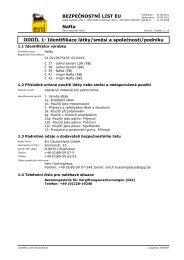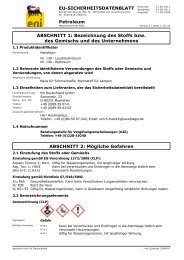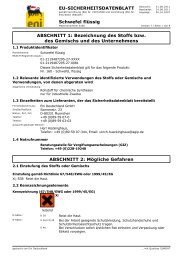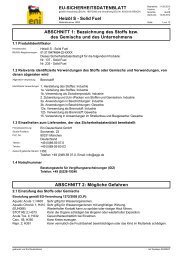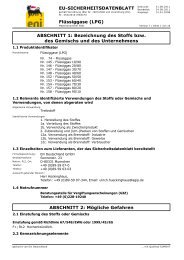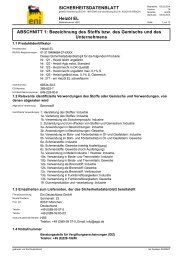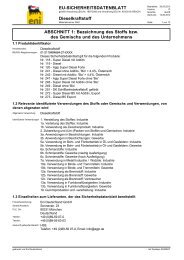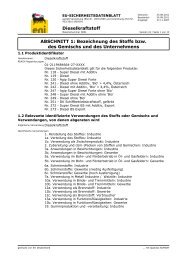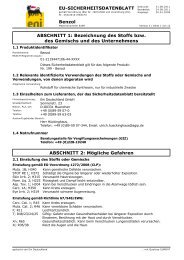- Page 1 and 2: EU-SICHERHEITSDATENBLATTgemäß Ver
- Page 3 and 4: EU-SICHERHEITSDATENBLATTgemäß Ver
- Page 5 and 6: EU-SICHERHEITSDATENBLATTgemäß Ver
- Page 7 and 8: EU-SICHERHEITSDATENBLATTgemäß Ver
- Page 9 and 10: EU-SICHERHEITSDATENBLATTgemäß Ver
- Page 11 and 12: EU-SICHERHEITSDATENBLATTgemäß Ver
- Page 13 and 14: Heavy Fuel Oil Components9. EXPOSUR
- Page 15 and 16: Heavy Fuel Oil ComponentsThe proces
- Page 17 and 18: Heavy Fuel Oil ComponentsCS2 Proces
- Page 19: Heavy Fuel Oil Components9.1.2. Exp
- Page 23 and 24: Heavy Fuel Oil Components9.3. Distr
- Page 25 and 26: Heavy Fuel Oil Componentsthe requir
- Page 27 and 28: Heavy Fuel Oil Components(closed sy
- Page 29 and 30: Heavy Fuel Oil Components9.4.2. Exp
- Page 31 and 32: Heavy Fuel Oil Componentscontrolled
- Page 33 and 34: Heavy Fuel Oil Components9.6. Uses
- Page 35 and 36: Heavy Fuel Oil Componentsreclaimed
- Page 37 and 38: Heavy Fuel Oil Components(closed sy
- Page 39 and 40: Heavy Fuel Oil Components9.7.2. Exp
- Page 41 and 42: Heavy Fuel Oil ComponentsCS15 Gener
- Page 43 and 44: Heavy Fuel Oil Components9.8.2. Exp
- Page 45 and 46: Heavy Fuel Oil Componentsand mainte
- Page 47 and 48: Heavy Fuel Oil Components9.10. Regi
- Page 49 and 50: Heavy Fuel Oil Components10.7. Uses
- Page 51 and 52: Heavy Fuel Oil Componentsno.: 60563
- Page 53 and 54: Heavy Fuel Oil ComponentsARCO (1990
- Page 55 and 56: Heavy Fuel Oil ComponentsUSA. Repor
- Page 57 and 58: Heavy Fuel Oil ComponentsARCO (1994
- Page 59 and 60: Heavy Fuel Oil ComponentsAssociates
- Page 61 and 62: Heavy Fuel Oil ComponentsUSA. Owner
- Page 63 and 64: Heavy Fuel Oil ComponentsUSA. Owner
- Page 65 and 66: Heavy Fuel Oil ComponentsRedman, et
- Page 67 and 68: Heavy Fuel Oil Components• : the
- Page 69 and 70: Heavy Fuel Oil Components 7.6 Surf
- Page 71 and 72:
Heavy Fuel Oil Components8.4.3 In v
- Page 73 and 74:
Heavy Fuel Oil Components9.2.1.1 Re
- Page 75 and 76:
Heavy Fuel Oil Components9.6.1 Long
- Page 77 and 78:
Heavy Fuel Oil ComponentsNote: High
- Page 79 and 80:
Heavy Fuel Oil Components 68512-6
- Page 81 and 82:
Heavy Fuel Oil Components2010-08-10
- Page 83 and 84:
Heavy Fuel Oil ComponentsReference
- Page 85 and 86:
Industrial: SU3 Industrial:
- Page 87 and 88:
ES4-W1 Industrial: SU3
- Page 89 and 90:
Heavy Fuel Oil ComponentsThere is a
- Page 91 and 92:
Heavy Fuel Oil Components2010-08-10
- Page 93 and 94:
Heavy Fuel Oil ComponentsReference
- Page 95 and 96:
Industrial: S
- Page 97 and 98:
ES4-W1 Industrial:
- Page 99 and 100:
Heavy Fuel Oil ComponentsA quantita
- Page 101 and 102:
Heavy Fuel Oil Componentsfor subseq
- Page 103 and 104:
Heavy Fuel Oil ComponentsThe Petror
- Page 105 and 106:
Heavy Fuel Oil Componentsanalysis o
- Page 107 and 108:
An Evaluation of the Persistence, B
- Page 109 and 110:
Table of ContentsExecutive Summary
- Page 111 and 112:
2.0 Outline of PBT/vPvB Assessment
- Page 113 and 114:
3.0 Persistence Assessment of Petro
- Page 115 and 116:
Figure 2. BioHCwin (Y-axis) vs. exp
- Page 117 and 118:
2,3-dimethylheptane 9 7.7 6.2 7.42,
- Page 119 and 120:
Figure 5. Half-life predictions for
- Page 121 and 122:
criterion. It can be concluded that
- Page 123 and 124:
Figure 9. Half-life predictions for
- Page 125 and 126:
HydrocarbonC nrBioHCwinPredictedHal
- Page 127 and 128:
Figure 13. Half-life predictions fo
- Page 129 and 130:
Figure 15. Half-life predictions fo
- Page 131 and 132:
HydrocarbonC nrBioHCwinPredictedHal
- Page 133 and 134:
enzo[a]pyrene 20 421.6 16.5Table 10
- Page 135 and 136:
(see Appendix 2). Since BCF predict
- Page 137 and 138:
100001000100101n-ParaffinsBvB00 5 1
- Page 139 and 140:
exhibit BMFs near unity (Figure 28)
- Page 141 and 142:
2,2,4,4,6,8,8-heptamethyl nonane16
- Page 143 and 144:
Hydrocarbon C BMFBCF(Arnot)DietaryB
- Page 145 and 146:
10000010000100010010DinaphthenicsBv
- Page 147 and 148:
4.5 Polynaphthenic hydrocarbonsRegr
- Page 149 and 150:
101Polynaphth. Dietary BMFBMF = 10.
- Page 151 and 152:
enzenen-octylbenzene 14 0.034 403 4
- Page 153 and 154:
100001000100101NMArBvB05 10 15 20 2
- Page 155 and 156:
and appears to be an outlier. This
- Page 157 and 158:
4-ethylbiphenyl 14 863 1039 CYakata
- Page 159 and 160:
10000010000100010010NDiArBvB110 15
- Page 161 and 162:
1010.1NDiAr Dietary BMFBMF = 10.011
- Page 163 and 164:
Hydrocarbon C BMFArnotBCFDietaryBCF
- Page 165 and 166:
Hydrocarbon C BMFArnotBCFDietaryBCF
- Page 167 and 168:
AcenaphtheneAcenaphthyleneBenz(a)an
- Page 169 and 170:
5.0 Summary of Persistence and Bioa
- Page 171 and 172:
lower water solubility, it is possi
- Page 173 and 174:
properties of petroleum hydrocarbon
- Page 175 and 176:
8.0 ReferencesAnonymous (2004). Fis
- Page 177 and 178:
EMBSI (2007c). Fish, dietary bioacc
- Page 179 and 180:
Prince RC, Walters CC. (2007). Biod
- Page 181 and 182:
Appendix 1. Hydrocarbon structures
- Page 183 and 184:
iP 14 2,4,10-Trimethylundecane CC(C
- Page 185 and 186:
MN 7 1,2-Dimethylcyclopentane CC1C(
- Page 187 and 188:
MN 14 n-Nonylcyclopentane CCCCCCCCC
- Page 189 and 190:
MN 29MN 29MN 30 n-Tetracosylcyclohe
- Page 191 and 192:
hexahydroindaneDN 20 2,4-dimethyloc
- Page 193 and 194:
PN 27Phenanthrene2,6-dimethylheptyl
- Page 195 and 196:
MAr 13 1-Methyl-3-hexylbenzene Cc1c
- Page 197 and 198:
NMAr 12 n-Propylindan c1ccc2CC(CCC)
- Page 199 and 200:
NMAr 24c1cc(CC(C)CCCC(C)CCCCC)c2CC(
- Page 201 and 202:
NMAr 29NMAr 29NMAr 29NMAr 29NMAr 29
- Page 203 and 204:
DAr 16 2-Hexylnaphthalene CCCCCCc1c
- Page 205 and 206:
NDAr 16 n-Butylacenaphthene c12cccc
- Page 207 and 208:
NDAr 26Dimethyloctyl-1,2,3,6,7,8-he
- Page 209 and 210:
PAr 19 Ethylbenzo(a)fluorene C3c1cc
- Page 211 and 212:
PAr 22 n-Pentylbenzo(a)fluorene C3c
- Page 213 and 214:
PAr 28 Isohexyl-octadecahydro-picen
- Page 215 and 216:
SummaryIn conducting a PBT assessme
- Page 217 and 218:
probabilities are adjusted to best
- Page 219 and 220:
1.2.2 OASIS LMC Models: Toxicologic
- Page 221 and 222:
environmental chemicals (database o
- Page 223 and 224:
dihydrodiol. These dihydroxylated i
- Page 225 and 226:
Table 1 : PBT assessment ofC15 stru
- Page 227 and 228:
1: The following structures were pr
- Page 229 and 230:
Dimitrov SD, Dimitrova N, Mekenyan
- Page 231 and 232:
hydrocarbons and azaarenes original
- Page 233 and 234:
Verhaar HJM, van Leeuwen CJ, Hermen
- Page 235 and 236:
CONCAWEAQUATIC TOXICITY PREDICTIONS
- Page 237 and 238:
CONTENTS (Continued)SectionPage15 S
- Page 239 and 240:
1-2The model predictions include me
- Page 241 and 242:
2-1SECTION 22 SUMMARY OF COMPOSITIO
- Page 243 and 244:
4-1SECTION 44 SUMMARY OF COMPOSITIO
- Page 245 and 246:
6-1SECTION 66 SUMMARY OF COMPOSITIO
- Page 247 and 248:
8-1SECTION 88 SUMMARY OF COMPOSITIO
- Page 249 and 250:
10-1SECTION 1010 SUMMARY OF COMPOSI
- Page 251 and 252:
12-1SECTION 1212 SUMMARY OF COMPOSI
- Page 253 and 254:
14-1SECTION 1414 SUMMARY OF COMPOSI
- Page 255 and 256:
16-1SECTION 1616 SUMMARY OF COMPOSI
- Page 257 and 258:
18-1SECTION 1818 SUMMARY OF COMPOSI
- Page 259:
20-1SECTION 2020 SUMMARY OF COMPOSI




